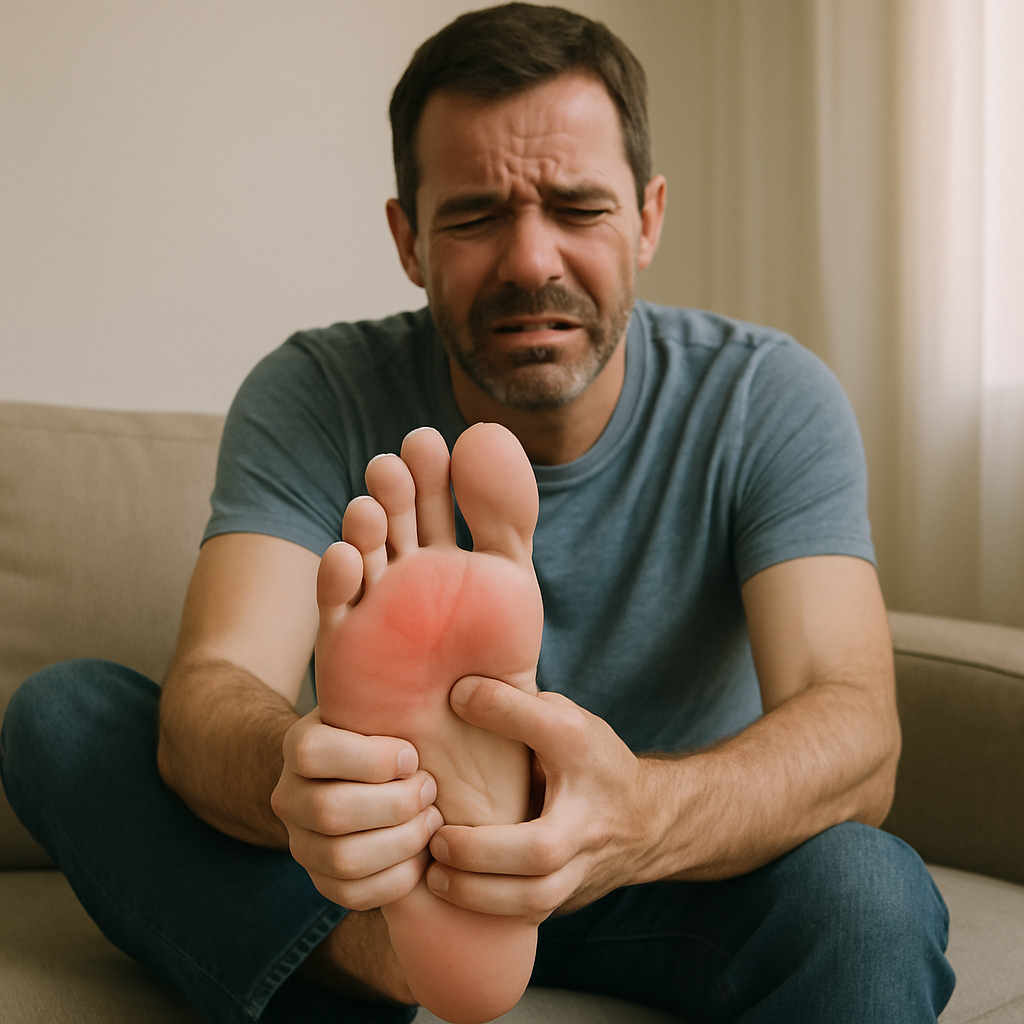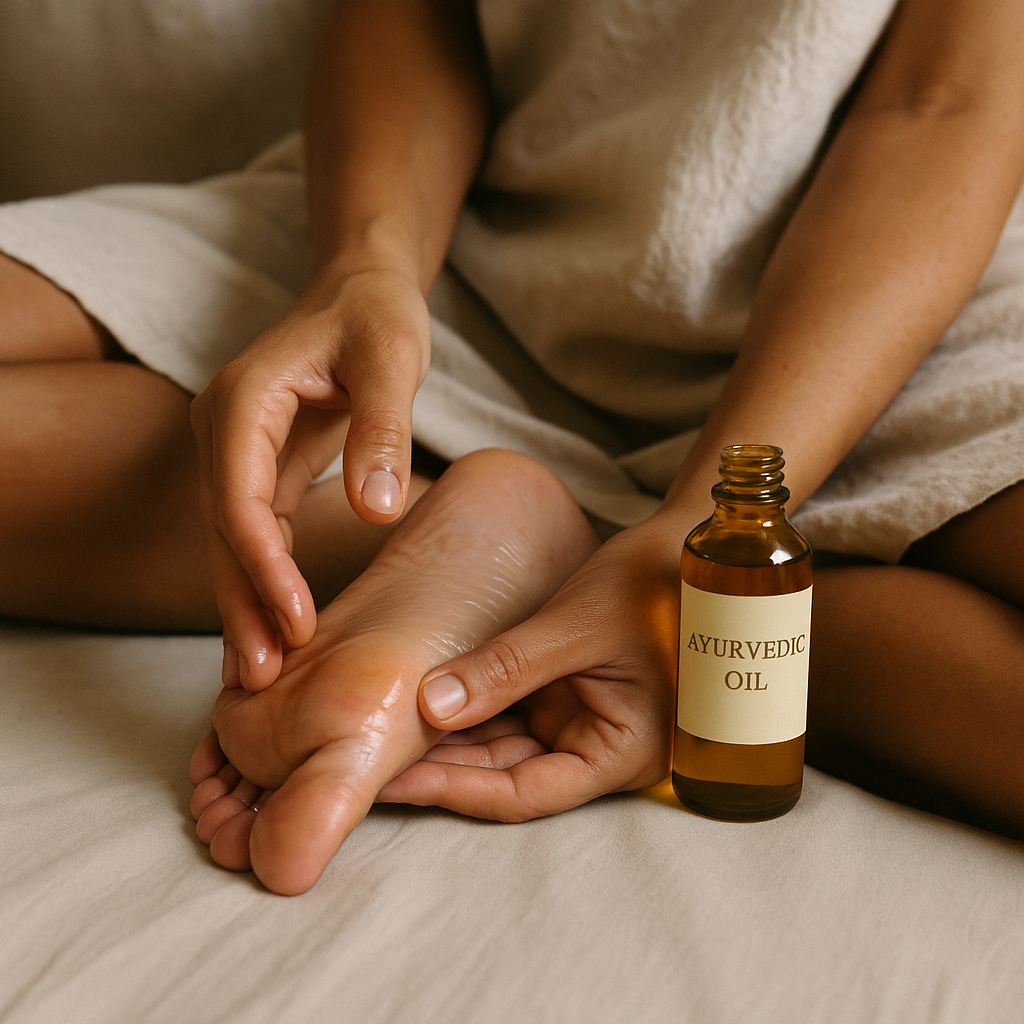Ask Ayurvedic doctor a question and get a consultation online on the problem of your concern in a free or paid mode. More than 2,000 experienced doctors work and wait for your questions on our site and help users to solve their health problems every day.
Shop Now in Our Store
How to Massage Feet to Relieve Pain: Ayurvedic Steps and Oils

There’s almost nothing as comforting as a good foot massage after a long day. Whether you're on your feet for hours or simply dealing with everyday stress, knowing how to massage feet to relieve pain can be a game-changer. It's not just about luxury or pampering — a well-done feet massage can boost circulation, reduce tension, and even help you sleep better.
In Ayurveda, massaging the feet is considered a powerful self-care ritual. The practice, called Padabhyanga, involves using specific feet massage oils and targeting vital foot massage points to release blocked energy and promote healing. And the best part? You don’t need to visit a spa. You can do a full foot massage at home with just your hands and a bit of know-how.
Let’s break it down — from how to massage feet and legs the Ayurvedic way, to which oils work best for deep, lasting relief.

When and Why to Do a Foot Massage to Relieve Pain
A foot massage isn’t just about relaxation — though let’s be honest, it feels amazing. Done right, it can actually help with headaches, back pain, anxiety, insomnia, and of course, tired feet. Timing matters too. Ayurveda recommends massaging your feet every evening before bed. That’s when the body’s energy (prana) begins to settle, making it the ideal moment for grounding practices like self-massage.
If you’ve been wondering how to massage feet to relieve pain, here’s something simple: start with clean feet and take a few deep breaths. Create a calm space. Set an intention. Trust me, it makes a difference.
Foot Massage Points and Pressure Techniques
Now, let’s dive into foot massage points and how to use your hands to bring them alive. Understanding these zones is essential when learning how to massage legs and feet effectively.
Key Foot Massage Points for Pain Relief
According to both Ayurveda and reflexology, the foot is a map of the entire body. Press one area, and it can influence another. For example:
-
The center of the heel relates to the lower back and sciatic nerves.
-
The ball of the foot is tied to the heart and lungs.
-
Toes — yep, those tiny things — connect to the sinuses and head.
So, if your back hurts, focus on the heel area. If you’re anxious or tired, stimulate the middle of the sole. You’ll be surprised how much difference this makes with regular practice.
Using Fingers, Knuckles, and Circular Motions
Here’s the fun part — how to actually do it. Start with long strokes from the toes to the heel. Then, use your thumbs to press into the arch using slow, steady pressure. Move in circles. Use your knuckles to gently knead sore spots. Don’t rush it. Some people get a little too aggressive (ouch), but it’s better to go gentle and gradually increase pressure if needed.
This is your time. Go slow. Listen to your body. And yeah, it’s totally fine if your technique isn’t perfect at first. Nobody’s grading you.

Best Oil for Feet Massage in Ayurveda
So now that you know how to massage feet, let’s talk about something equally important: the oil. In Ayurveda, oils aren’t just for lubrication — they’re therapeutic tools chosen according to your dosha (body type). Picking the best oil for feet massage can really boost the benefits you get from the practice.
The right feet massage oil can help reduce inflammation, improve skin texture, and even support emotional wellbeing. Pretty wild, right?
Cooling vs. Warming Oils for Different Body Types
Ayurveda recognizes three main doshas — Vata, Pitta, and Kapha — and each responds differently to oils.
-
Vata types (dry, anxious, easily cold) do best with warming, grounding oils like sesame oil or ashwagandha-infused oils. These are deeply nourishing and calm the nervous system.
-
Pitta types (fiery, intense, prone to inflammation) should opt for cooling oils like coconut oil or brahmi oil. These help soothe excess heat in the body.
-
Kapha types (heavy, sluggish, oily) benefit from light, invigorating oils like mustard oil or eucalyptus blends that improve circulation and reduce stagnation.
If all that feels like too much, just start with warm sesame oil. It’s considered universally balancing and is a go-to in most Ayurvedic massage routines. Plus, it smells earthy and kinda amazing (unless you hate that sorta thing, which — fair enough).
How to Apply Feet Massage Oil for Deep Relief
Here’s a simple step-by-step to apply feet massage oil like a pro:
-
Warm the oil slightly. Don’t microwave it! Use a small bowl placed in warm water instead.
-
Apply oil generously to each foot, starting from the toes and working down toward the heel and ankle.
-
Massage each toe individually — squeeze, rotate, and gently pull.
-
Spend time on the feet massage points mentioned earlier. Use your thumbs to apply pressure in circular motions.
-
Don’t forget the ankles and lower legs. When learning how to massage legs and feet, people often skip the lower leg, but it’s crucial for full-body relaxation.
-
After 10-15 mins, wear cotton socks (if it’s bedtime) or rinse off with warm water.
Important tip: Don’t slip and fall. That’s not a very relaxing way to end a massage.
Conclusion
Knowing how to massage feet to relieve pain can be a game-changer for your daily wellbeing. It’s one of those things that seems small — like brushing your teeth or drinking enough water — but the impact adds up over time. With the right foot massage points, good technique, and the best oil for feet massage, you can turn five minutes into a healing ritual.
The beauty of foot massage at home is its simplicity. You don’t need a fancy setup. Just your hands, some oil, and a little presence. That’s all it takes to feel more grounded and at ease.
FAQs
Does massage help nerve pain in feet?
Yes, it often does. While it’s not a miracle fix, regular foot massage can help ease nerve-related discomfort, especially in conditions like peripheral neuropathy or diabetes-related foot pain. By stimulating foot massage points and improving blood flow, massage may help reduce tingling, numbness, and even that weird pins-and-needles feeling that drives people nuts. Just be careful not to go too hard — gentle, consistent pressure is usually better than a deep dig.
Who should not use foot massagers?
Good question. People with certain health issues — like deep vein thrombosis (DVT), uncontrolled diabetes, or open wounds on the feet — should talk to a doctor before using any kind of electric foot massager or attempting deep tissue massage. Also, if you're pregnant, you should be cautious. Some feet massage points are known to stimulate uterine activity, so yeah, maybe hold off unless your doc gives the green light.
Final Thoughts: Bring the Ritual Home
If you’ve ever searched for how to massage feet, chances are you were looking for relief — from pain, from stress, from the everyday grind. The good news? You’ve got everything you need right at your fingertips (literally).
Massaging your own feet might feel awkward at first. Like, what am I doing with my thumbs again? But it gets easier. And once you start feeling that warm, tingly release spreading through your legs, you’ll get it. You’ll want to do it again. And again. And then maybe even teach your partner how to massage feet (so you can trade, of course — not because you're feeling generous or anything).
Remember:
-
Choose the right feet massage oil for your body.
-
Learn your foot massage points — they’re like magic buttons.
-
Take your time. Breathe. Enjoy it.
-
Do it before bed for best results. Or, do it whenever your feet scream, “hey, help!”
We spend so much time ignoring our feet — stuffing them into tight shoes, standing for hours, walking all day. It’s no wonder they hurt. But you don’t have to live with that pain.
So next time you're scrolling TikTok or binging Netflix, pause for a few minutes. Grab your oil, sit down, and give your feet the love they deserve. It’s cheap, it’s simple, and it’s probably the most underrated self-care hack out there.
Tried the techniques from this article? Share it with someone whose feet are always sore — you know the one. They’ll thank you (maybe even with a massage back).
And if you want more Ayurvedic self-care rituals or tips on natural pain relief, subscribe to our newsletter or follow us on social. Your feet (and your nervous system) will thank you.
This article is checked by the current qualified Dr Sujal Patil and can be considered a reliable source of information for users of the site.

